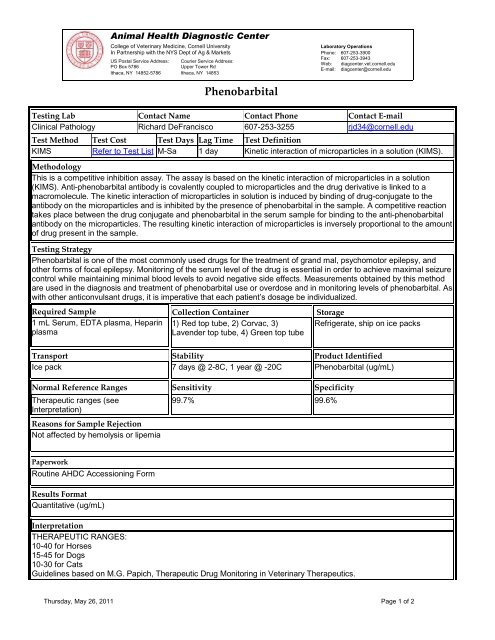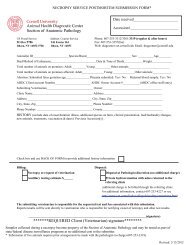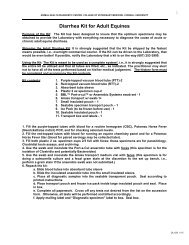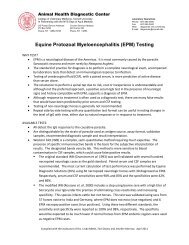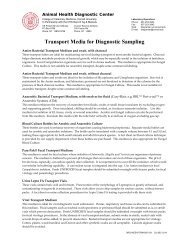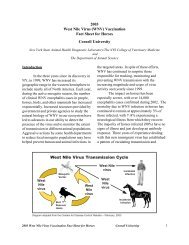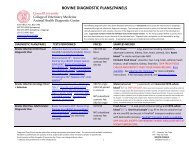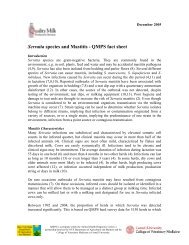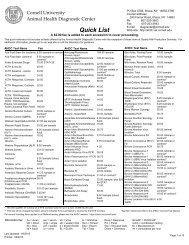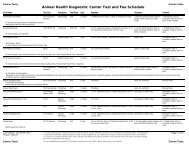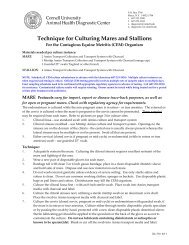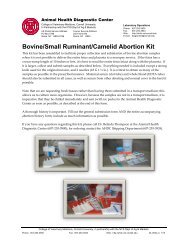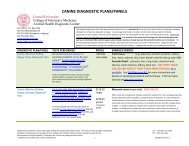Phenobarbital - Animal Health Diagnostic Center - Cornell University
Phenobarbital - Animal Health Diagnostic Center - Cornell University
Phenobarbital - Animal Health Diagnostic Center - Cornell University
You also want an ePaper? Increase the reach of your titles
YUMPU automatically turns print PDFs into web optimized ePapers that Google loves.
<strong>Animal</strong> <strong>Health</strong> <strong>Diagnostic</strong> <strong>Center</strong><br />
College of Veterinary Medicine, <strong>Cornell</strong> <strong>University</strong><br />
In Partnership with the NYS Dept of Ag & Markets<br />
US Postal Service Address: Courier Service Address:<br />
PO Box 5786<br />
Upper Tower Rd<br />
Ithaca, NY 14852-5786 Ithaca, NY 14853<br />
Laboratory Operations<br />
Phone: 607-253-3900<br />
Fax: 607-253-3943<br />
Web: diagcenter.vet.cornell.edu<br />
E-mail: diagcenter@cornell.edu<br />
Testing Lab<br />
Clinical Pathology<br />
Test Method<br />
KIMS<br />
Test Cost<br />
Refer to Test List<br />
Contact Name<br />
Richard DeFrancisco<br />
<strong>Phenobarbital</strong><br />
Contact Phone<br />
607-253-3255<br />
Contact E-mail<br />
rjd34@cornell.edu<br />
Methodology<br />
This is a competitive inhibition assay. The assay is based on the kinetic interaction of microparticles in a solution<br />
(KIMS). Anti-phenobarbital antibody is covalently coupled to microparticles and the drug derivative is linked to a<br />
macromolecule. The kinetic interaction of microparticles in solution is induced by binding of drug-conjugate to the<br />
antibody on the microparticles and is inhibited by the presence of phenobarbital in the sample. A competitive reaction<br />
takes place between the drug conjugate and phenobarbital in the serum sample for binding to the anti-phenobarbital<br />
antibody on the microparticles. The resulting kinetic interaction of microparticles is inversely proportional to the amount<br />
of drug present in the sample.<br />
Testing Strategy<br />
<strong>Phenobarbital</strong> is one of the most commonly used drugs for the treatment of grand mal, psychomotor epilepsy, and<br />
other forms of focal epilepsy. Monitoring of the serum level of the drug is essential in order to achieve maximal seizure<br />
control while maintaining minimal blood levels to avoid negative side effects. Measurements obtained by this method<br />
are used in the diagnosis and treatment of phenobarbital use or overdose and in monitoring levels of phenobarbital. As<br />
with other anticonvulsant drugs, it is imperative that each patient’s dosage be individualized.<br />
Required Sample<br />
1 mL Serum, EDTA plasma, Heparin<br />
plasma<br />
Test Days<br />
M-Sa<br />
Lag Time<br />
1 day<br />
Collection Container<br />
1) Red top tube, 2) Corvac, 3)<br />
Lavender top tube, 4) Green top tube<br />
Test Definition<br />
Kinetic interaction of microparticles in a solution (KIMS).<br />
Storage<br />
Refrigerate, ship on ice packs<br />
Transport<br />
Ice pack<br />
Normal Reference Ranges<br />
Therapeutic ranges (see<br />
Interpretation)<br />
Reasons for Sample Rejection<br />
Not affected by hemolysis or lipemia<br />
Stability<br />
7 days @ 2-8C, 1 year @ -20C<br />
Sensitivity<br />
99.7%<br />
Product Identified<br />
<strong>Phenobarbital</strong> (ug/mL)<br />
Specificity<br />
99.6%<br />
Paperwork<br />
Routine AHDC Accessioning Form<br />
Results Format<br />
Quantitative (ug/mL)<br />
Interpretation<br />
THERAPEUTIC RANGES:<br />
10-40 for Horses<br />
15-45 for Dogs<br />
10-30 for Cats<br />
Guidelines based on M.G. Papich, Therapeutic Drug Monitoring in Veterinary Therapeutics.<br />
Thursday, May 26, 2011 Page 1 of 2
15-45 for Dogs<br />
10-30 for Cats<br />
Guidelines based on M.G. Papich, Therapeutic Drug Monitoring in Veterinary Therapeutics.<br />
<strong>Animal</strong>sTested<br />
Amphibia Avian Bovine Camelid Canine Caprine Cervid Equine Ferret<br />
No<br />
Yes<br />
Validation<br />
completed 4/7/11<br />
Yes<br />
Yes<br />
Yes<br />
Yes<br />
No<br />
Yes<br />
No<br />
Fish<br />
No<br />
Feline<br />
Yes<br />
Mammal<br />
No<br />
Ovine<br />
No<br />
Porcine Reptile Other<br />
No<br />
No<br />
No<br />
Primate<br />
No<br />
Key Words<br />
Clinical Pathology, <strong>Phenobarbital</strong>, Analytical<br />
References<br />
M.G. Papich, Therapeutic Drug Monitoring, In: Veterinary Pharmacology & Therapeutics, 9th<br />
edition, pp. 1323-1330 (2009).<br />
Roche <strong>Diagnostic</strong>s GmbH, Sandhofer Strasse 116, D-68305 Mannheim, Roche <strong>Diagnostic</strong>s,<br />
Indianapolis, IN<br />
Thursday, May 26, 2011 Page 2 of 2


